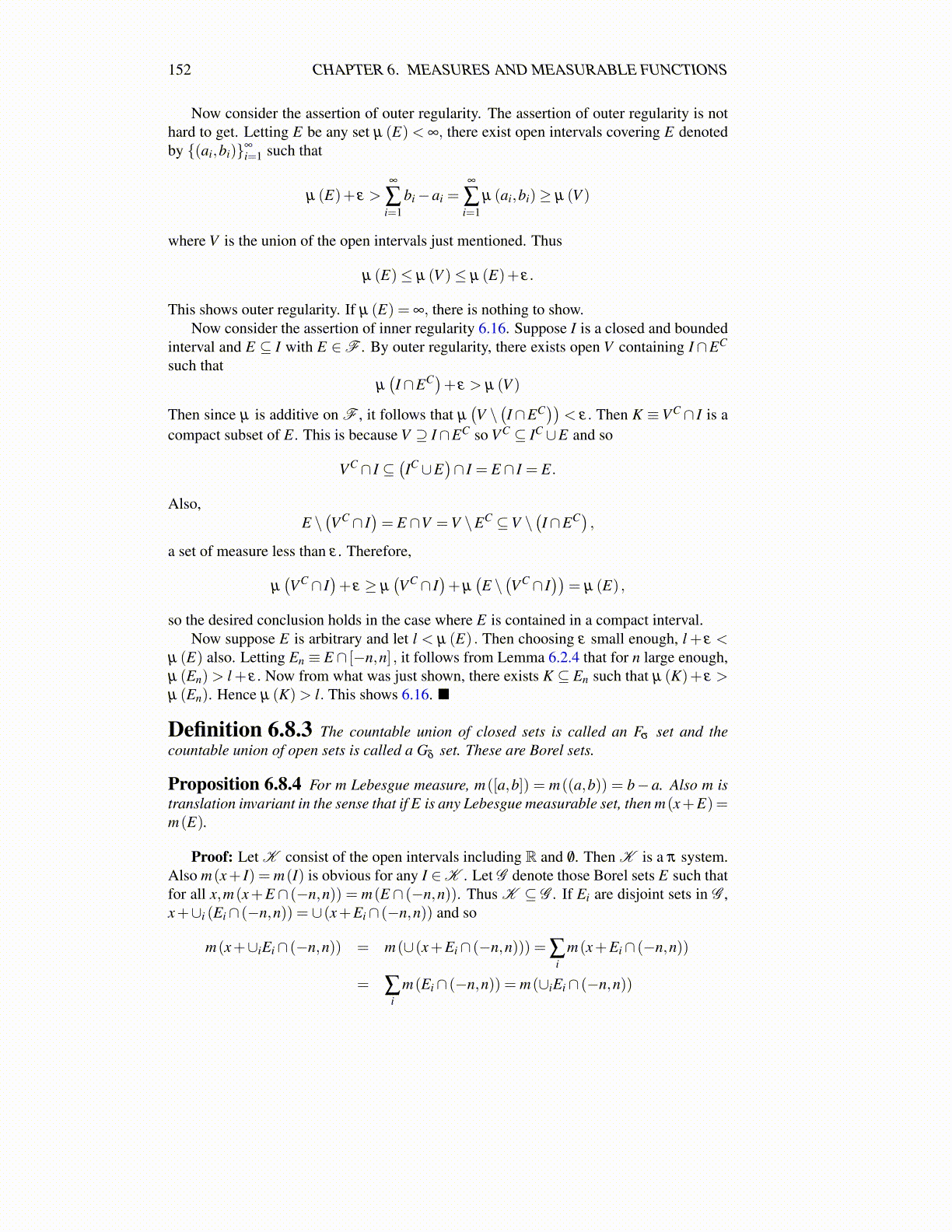
152 CHAPTER 6. MEASURES AND MEASURABLE FUNCTIONS
Now consider the assertion of outer regularity. The assertion of outer regularity is nothard to get. Letting E be any set µ (E)< ∞, there exist open intervals covering E denotedby {(ai,bi)}∞
i=1 such that
µ (E)+ ε >∞
∑i=1
bi−ai =∞
∑i=1
µ (ai,bi)≥ µ (V )
where V is the union of the open intervals just mentioned. Thus
µ (E)≤ µ (V )≤ µ (E)+ ε.
This shows outer regularity. If µ (E) = ∞, there is nothing to show.Now consider the assertion of inner regularity 6.16. Suppose I is a closed and bounded
interval and E ⊆ I with E ∈F . By outer regularity, there exists open V containing I∩EC
such thatµ(I∩EC)+ ε > µ (V )
Then since µ is additive on F , it follows that µ(V \(I∩EC
))< ε. Then K ≡ VC ∩ I is a
compact subset of E. This is because V ⊇ I∩EC so VC ⊆ IC ∪E and so
VC ∩ I ⊆(IC ∪E
)∩ I = E ∩ I = E.
Also,E \(VC ∩ I
)= E ∩V =V \EC ⊆V \
(I∩EC) ,
a set of measure less than ε . Therefore,
µ(VC ∩ I
)+ ε ≥ µ
(VC ∩ I
)+µ
(E \(VC ∩ I
))= µ (E) ,
so the desired conclusion holds in the case where E is contained in a compact interval.Now suppose E is arbitrary and let l < µ (E) . Then choosing ε small enough, l + ε <
µ (E) also. Letting En ≡ E ∩ [−n,n] , it follows from Lemma 6.2.4 that for n large enough,µ (En)> l + ε. Now from what was just shown, there exists K ⊆ En such that µ (K)+ ε >µ (En). Hence µ (K)> l. This shows 6.16. ■
Definition 6.8.3 The countable union of closed sets is called an Fσ set and thecountable union of open sets is called a Gδ set. These are Borel sets.
Proposition 6.8.4 For m Lebesgue measure, m([a,b]) = m((a,b)) = b− a. Also m istranslation invariant in the sense that if E is any Lebesgue measurable set, then m(x+E)=m(E).
Proof: Let K consist of the open intervals including R and /0. Then K is a π system.Also m(x+ I) = m(I) is obvious for any I ∈K . Let G denote those Borel sets E such thatfor all x,m(x+E ∩ (−n,n)) = m(E ∩ (−n,n)). Thus K ⊆ G . If Ei are disjoint sets in G ,x+∪i (Ei∩ (−n,n)) = ∪(x+Ei∩ (−n,n)) and so
m(x+∪iEi∩ (−n,n)) = m(∪(x+Ei∩ (−n,n))) = ∑i
m(x+Ei∩ (−n,n))
= ∑i
m(Ei∩ (−n,n)) = m(∪iEi∩ (−n,n))